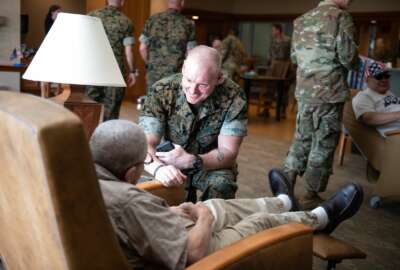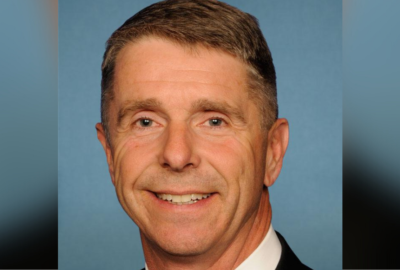The armed forces are urged to better evaluate field medicine
Not all military health care takes place in ideal settings. The armed forces exercise varying degrees of how carefully they evaluate provider quality.
Not all military health care takes place in ideal settings. Sometimes it’s needed in what the military calls operational settings. The armed forces exercise varying degrees of how carefully they evaluate provider quality. Sharon Silas, director of health care issues at the Government Accountability Office, joined the Federal Drive with Tom Temin for more.
Interview transcript:
Tom Temin: And let’s begin with a couple of definitions here. Operational settings. I think people think of that and they think of MASH, but that’s not necessarily what it really is.
Sharon Silas: Yeah. So operational settings is when medical care is provided and any settings that are outside of the military treatment facilities. So this could include field hospitals or aircraft carriers or hospital ships. And the settings are usually temporary. So they’re temporarily in place to help the military meet its missions. But their medical providers can be providing a whole range of types of care. So it could be anywhere from first responder to trauma care. They could be doing complex medical care, such as surgeries, and they can be treating military service members that have battle or non-battle injuries, or they could be treating civilians through their humanitarian efforts. But what makes these operational settings very unique is that sometimes they can be in combat zones, but oftentimes they’re geographically remote. These can be unpredictable environments. They often have rapidly evolving conditions, and they don’t usually have the types of resources that you would typically see in a hospital or a medical center. So they might not have a lab or they might not have access to a centralized system to manage their health care information.
Tom Temin: And I guess anything can happen if you’re on a carrier for six months or something or say on a sub, even for months at a time. You may not get injured in a battle situation, but you could have an appendix attack, which is a medical emergency. You got to take that taken care of and there’s a few other things I can think of. And so what happens then? In that case, you would maybe have care aboard that very ship or vessel or maybe be moved to another one, but not to a land-based situation?
Sharon Silas: Yeah, that’s correct. These medical providers are providing care to patients in these operational settings. And again, they can be very unique depending on if it’s the Navy and it’s an aircraft carrier or if it’s Air Force and it could be a field hospital.
Tom Temin: And the providers are military personnel for the most part? They’re not contractors or the places that might help fill in what’s needed at a land based military health system facility?
Sharon Silas: Yes, that’s correct.
Tom Temin: So you were looking then at how closely the armed services evaluate the care given in those operational settings?
Sharon Silas: Yes, we looked at two types of clinical care processes. We looked at the first process we looked at is the privileging process. So this is a process to assess whether the medical providers are competent, provide certain types of medical care based on a review of their skills, qualifications and experience. So, for example, a primary care physician will have a scope of practice with a certain set of skills needed to provide care that would be very different than what a cardiologist would be doing. We also looked at performance evaluation processes. So this is when there is an evaluation of the medical provider’s performance and competence, and that is supposed to be done on a continuing basis every six months. And then also at the end of their deployment.
Tom Temin: And there must be the issue, too, of women’s care since they are employed on ships and so forth and in difficult distant situations in the armed forces. And you may not need an obstetrician to deliver a baby or something, but you might need specialized women’s care that traditionally might not have been offered. Does that part of what you are looking at also?
Sharon Silas: So yeah. So in terms of the privileging, when you’re looking at the skills and qualifications and experience, maybe that provider is providing a certain type of care in the military treatment facility, but those skills and qualifications after they’re assessed might be able to be translated out to providing different type of care in the field.
Tom Temin: And by the way, does dental come up? I mean, it could something could happen with a tooth and you don’t want a general practitioner or someone who’s competent at putting in a stent drilling a tooth.
Sharon Silas: Yeah. And for the scope of this work, we didn’t look specifically at the types of providers that were in these operational environments. But I could imagine if there is a dental emergency, you would want to have a provider that had the skills and qualifications that could treat you properly.
Tom Temin: We’re speaking with Sharon Silas, director of health care issues at the Government Accountability Office. And what did you find? I mean, how good are the armed services at maintaining the competencies and privileging required? And you looked at the policies covering privileging and competency, and what did you find?
Sharon Silas: So what we found was that none of the military departments of Navy, Air Force, Army, which was who we looked at as part of this review, none of the military departments had updated their policies for privileging and performance evaluation of these medical providers in the operational settings since prior to 2016. And this is really important because prior to 2016, each military department manage their own clinical care policies and processes. But in 2016, DoD began transitioning oversight of clinical care to the Defense Health Agency. So the military department policies for these operational settings do not really reflect the updated DoD and Defense Health Agency guidance and specifically with updated policy to say is that Defense Health Agency is responsible for managing clinical quality care at the military treatment facilities. But for operational settings, the military departments retain that oversight role. The other key change in the policies was that the military departments were directed to have policies in place in these operational settings that aligned with the Defense Health Agency policy to the extent that it’s possible.
Tom Temin: Right. So there is a little bit of an orphan trial that occurred there that they need to pick up, in other words, from a policy standpoint?
Sharon Silas: Yes, that’s correct. And what we found was that the military departments were in varying stages of updating and finalizing these policies and to align them with the new requirements. And what we found was that the Navy was furthest along, followed by Air Force, and then the Army was furthest behind in terms of updating their policies to reflect the new guidance from DoD.
Tom Temin: Right. So the Army then is the little bit of a laggard there. And then you looked at also how well they do performance evaluation of the care delivered and that would seem to be really crucial to the troops involved. And what was the situation there?
Sharon Silas: Sure. So for both Navy and Air Force, they were able to describe the processes they were using not only to evaluate medical provider’s performance, but also for their privileging processes. And what we had to do since there were not updated policies is that we requested documentation of the processes to ensure that they were being performed. And generally, both of the departments of Navy and Air Force were able to provide most of the documentation that provided evidence that these processes were being conducted. But because of the unique challenges of the operational settings, we weren’t always able to get complete documentation of these reviews. So, for example, the Air Force, they had 41 providers that we looked at as part of this review. They were temporarily assigned to these operational settings within the scope of our review, but they weren’t able to provide us complete records because documents weren’t able to be saved during rabid closure of the operational setting. And then we also looked at Army, and again, they were kind of lagging behind. Army officials were not able to articulate a consistent process for privileging or evaluating providers in these operational settings. And so as we describe in our report, we say that finalizing and issuing their policies in alignment with the DoD policy will help them to standardize their processes for privileging and for evaluating these medical provider’s performance.
Tom Temin: And this is a moving target, isn’t it? I mean, the types of competencies you might need or the privileges as medical science changes and as standards issued by the medical bodies change, the military has to keep up. You might need a different complement of people in a military field hospital, for example, now than you might have in, say, 2010 or 2000 or 1950.
Sharon Silas: Yeah, and that’s correct. And you might need a different type of skill set for the medical providers, just kind of depending on what’s going on in that operational setting. And so the medical providers are pulled from the military treatment facilities and brought out to these operational settings. And through that process, there is a review of the privileges that they have at the military treatment facilities and to see if they’re transferable for the providers to provide care in these operational settings.
Tom Temin: And the authorities that you made recommendations to basically to update your policies, they pretty much agreed with that?
Sharon Silas: Yes. All the military departments agreed with our recommendations.
Tom Temin: All right. Yes. You don’t want again a dentist putting in a stent. Which end do I go through? That could be kind of upsetting.
Copyright © 2025 Federal News Network. All rights reserved. This website is not intended for users located within the European Economic Area.
Tom Temin is host of the Federal Drive and has been providing insight on federal technology and management issues for more than 30 years.
Follow @tteminWFED







